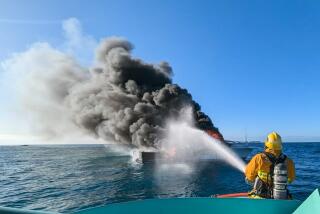Last Rites for a Princess : Ill-Fated Louise Sinks--but Not at the Intended Burial Spot
- Share via
Seven months after it mysteriously capsized in a Terminal Island shipyard, the former cruise liner Princess Louise was towed Wednesday to a watery grave off the Southern California coast. But its final voyage, like its final days, proved as troublesome as ever.
Sinking miles and hours before it could reach its intended destination off the coast of Santa Catalina Island, the 1921 vessel foiled months of preparation by divers, naval architects, salvage experts and insurance underwriters.
“It didn’t make it as far as it was supposed to, but these things can happen,” said Coast Guard spokesman Reid Crispino. “And as far as being any hazard to navigation, it’s not.”
The 330-foot vessel, Crispino said, sank at 2:08 p.m. about nine miles south of Point Fermin, 900 feet below the main shipping lanes of Los Angeles Harbor, but within the San Pedro Channel.
Six hours earlier, its once-gleaming hull rusted and patched with plywood, the Princess Louise was pulled by tugboats from Berth 241. Escorted by the Coast Guard, it headed slowly out to sea, carrying half a dozen divers whose final mission was to scuttle the ship in deep waters 20 miles southwest of Santa Catalina Island.
The site for the ship’s burial had been approved by the Environmental Protection Agency, which oversees an ocean dumping site 5,000 feet deep off Catalina.
But long before it reached that destination, the boat began taking on water and sank.
“This is where we didn’t want it to go. This is what we didn’t want to happen,” EPA spokeswoman Lois Grunwald said shortly after learning that the ship went down within the busy channel. Earlier, EPA officials said they wanted the ship sunk outside the channel to avoid any problems for shipping, fishing or other marine activities.
While Coast Guard officials do not foresee any such problems, they and Grunwald said the sinking will be investigated. One reason for their inquiry was the ship owner’s request Wednesday for permission to scuttle the vessel before it reached Catalina. That request was never approved, Grunwald said.
Early Wednesday, the ship’s owner and salvager, Willem Boelman, said he had hoped to receive EPA permission to sink the boat short of the island because he was concerned about its seaworthiness and the danger of towing the vessel in high seas after dark.
“Otherwise, it’ll take us 30 hours to reach Catalina,” Boelman, president of Trinav Shipping Ltd. of Vancouver, Canada, said around sunrise.
By late afternoon, Boelman’s concern about the vessel’s seaworthiness appeared prophetic, as Coast Guard officials reported the vessel foundering.
The ship’s finale was typical of its recent history.
Built in 1921 in Vancouver and once known as “Queen of the Northern Seas,” the Princess Louise arrived in San Pedro in 1966 and was a popular floating restaurant until the late 1980s. Its then-owner declared bankruptcy in 1988 and the ship was repossesed by the Bank of San Pedro.
For months, the vessel, which once cruised the Alaskan straits, sat idle in Los Angeles Harbor before being moved last September to the Southwest Marine shipyards for repairs that the bank hoped would draw a buyer.
But on Oct. 30, minutes after repair crews left for lunch, the 2,300-ton vessel suddenly capsized. . The cause of its sinking is still a matter of contention between the bank, Southwest Marine and Lloyds of London, which carried the $1.5-million insurance policy on the vessel.
And just before it was raised two weeks ago, Boelman and Los Angeles police disclosed that the vessel had been plundered by divers.
Notwithstanding its recent misfortunes, there were plenty of dockworkers Wednesday who were sorry to see the end of the once-majestic vessel.
“It’s sad,” said Bob Blake, ship superintendent for Southwest Marine.
More to Read
Sign up for Essential California
The most important California stories and recommendations in your inbox every morning.
You may occasionally receive promotional content from the Los Angeles Times.













